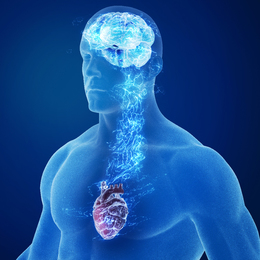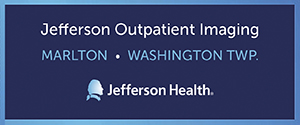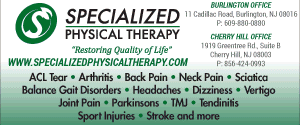
A Matter of the Heart— and Brain
Getting to know the risks and recovery options for a heart attack or stroke.
More than 859,000 Americans die of heart disease, stroke or other cardiovascular diseases each year, according to the Centers for Disease Control. That is one-third of all U.S. deaths. Knowing the warning signs of a heart attack or stroke, as well as your options for recovery, can be truly life saving.
Both heart attacks and strokes are caused by interruption of blood flow. In the case of a heart attack, blood flow to a part of the heart is blocked (typically by a clot). In the case of a stroke, a blood vessel feeding the brain gets clogged or bursts. Both are life-threatening emergencies in which time is of the essence.
Because of this, it’s important to educate yourself on the warning signs. According to Dr. Jennifer Caudle, associate professor, department of family medicine, Rowan University School of Osteopathic Medicine, symptoms of a heart attack may include chest pain or pressure; pain or discomfort in the neck, jaw or arms (or sometimes in the back); and sometimes shortness of breath, nausea or lightheadedness—though there are other potential symptoms as well.
According to Caudle, symptoms of a stroke include facial drooping or numbness, trouble speaking and arm weakness or numbness, among other symptoms.
Dr. Sarah E. West, a neuropsychologist from Bancroft NeuroRehab, says that the acronym FAST often helps people remember the signs of a stroke. This stands for “face, arms, speech and time,” the last one being that it is “time to call 9-1-1” if any of these symptoms are present.
“If you think you notice a droop in the person’s face or they are suddenly slurring their words, ask them to smile,” says West. “If one side of the face does not match the other, this is a sign that the individual may be experiencing a stroke and you should get help immediately.”
West says that time truly is of the essence when it comes to stroke care. Research indicates that the optimal time frame for treating a stroke is typically three to four-and-a-half hours. This is because a clot-busting medication is most effective within that window. In addition, the longer blood flow is blocked, the more potential for damage.
Knowing Your Risk
It’s so important to have a good understanding of the risk factors that may make you more likely to suffer from a stroke or heart attack. According to Caudle, risk factors that can affect cardiovascular health include high blood pressure, high cholesterol, sedentary lifestyle, high blood sugar, excess alcohol intake, smoking, diet, age and obesity. Of course, family history is also an important risk factor.
“It is important to see your doctor regularly to find out what specific things you need to be doing to stay healthy,” Caudle adds. “Also, keeping healthy blood pressure, cholesterol and blood sugar levels; not smoking; drinking alcohol in moderation; exercising; and eating a healthy diet are important.”
Advancing Care
Fortunately, cardiac and stroke care are advancing rapidly in our region. There are improved options in terms of early detection, treatment and recovery options.
“Hospitals in the region are stepping up their game and appear to be bringing on more endovascular specialists who can not only help to prevent stroke better through stabilizing or removing structural defects in brain blood vessels—like aneurysms or vascular anomalies—but they are also better equipped to operate inside the brain vasculature quicker and more effectively remove clots and re-establish blood flow to the brain,” says Dr. Steven M. Bromley, director of South Jersey MS Center and Bromley Neurology PC.
Bromley says that medications related to stroke are also improving. And improvements in the ability to thin the blood and help prevent stroke— such as with atrial fibrillation and carotid stenosis—are newer and in many ways safer than previously used anticoagulants.
Recovery care has also come so far with ever-advancing rehabilitation options. West says that although people will recover from a stroke whether they are in rehab or not, the value of rehab is that patients will recover more quickly and more fully. This is of major importance when it comes to resuming life activities.
“There is special accreditation given to stroke programs at rehabilitation centers so that’s an important thing to look for,” says West. “You also want to make sure that the therapist you are working with has specific experience working with stroke patients. There are a lot of places that offer physical therapy but that doesn’t mean they will have all of the knowledge related to recovery from stroke.”
West says that physical therapy for someone recovering from stroke needs to address the cognitive difficulties that individual may face. Stroke can also impact the ability to communicate. This can add a layer of difficulty.
It can also be beneficial to seek a rehabilitation center that has many different therapies all under one roof. This helps the various members of the rehab team to all be able to communicate with one another for a truly comprehensive care model. At Bancroft, there is even vocational rehabilitation for individuals who plan to return to work and need job coaching.
“The bottom line is that there are a lot of resources available and people aren’t always aware of them all,” West adds. “The goal is always to help patients return to their optimal level of functioning.”
To read the digital edition of South Jersey Magazine, click here.
Published (and copyrighted) in South Jersey Magazine, Volume 16, Issue 11 (February 2020).
For more info on South Jersey Magazine, click here.
To subscribe to South Jersey Magazine, click here.
To advertise in South Jersey Magazine, click here.












